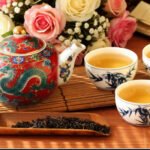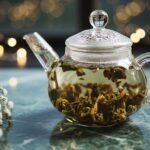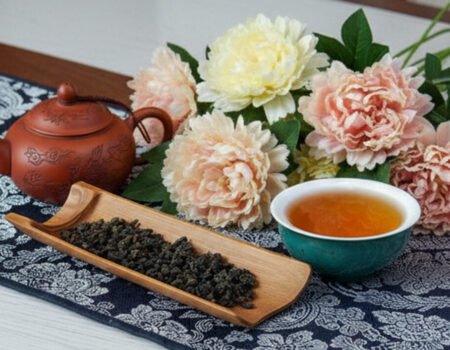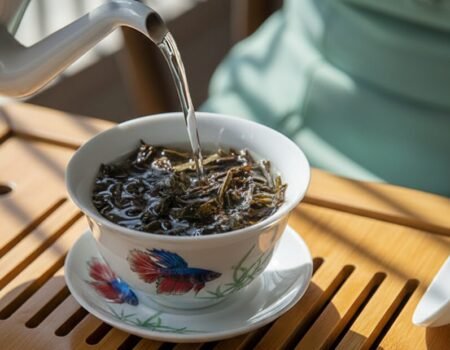
How to Brew Tea Leaves: Making the Perfect Cup of Loose Leaf Tea
Index
Index
Loose leaf tea contains larger, more intact pieces than bagged tea, which allows for better flavor but could make handling a bit tricky. The quality of your brew depends on several factors: water temperature, steeping time, and the right tools.
This guide will walk you through each step of brewing loose leaf tea, from selecting the right teapot to removing the leaves after steeping.
Key Takeaways
- Different tea types need specific water temperatures—black tea at 212°F (100°C), Green and white tea between 175-185°F (79-85°C), and oolong at 195°F (90.5°C), for Pu-erh, Rooibos and Herbal Tea also at 212°F (100°C.)
- Use one teaspoon of tea leaves per six ounces of water for most teas, but white tea needs two teaspoons for the same amount.
- Steeping time varies by tea type: black tea needs 3-5 minutes, Japanese green tea just 1-2 minutes, and herbal teas require 5-10 minutes.
- Remove tea leaves promptly after steeping to prevent bitterness. Used leaves make excellent garden compost.
- The right tools enhance your tea experience. A glass teapot lets you watch leaves expand, while an electric kettle helps achieve precise temperatures.
Step-by-Step Guide to Brewing Loose Leaf Tea

Brewing loose leaf tea takes just a few steps but makes a big difference in taste. Follow this guide to transform simple leaves into a perfect cup that will delight your senses.
Quick Brewing Reference Chart:
| Tea Type | Water Temperature | Amount per 6 oz (175 ml) | Steeping Time |
|---|---|---|---|
| Black Tea | 212°F (100°C) | 1 teaspoon | 3-5 minutes |
| Green Tea | 175-185°F (79-85°C) | 1 teaspoon | 1-2 minutes |
| White Tea | 175-185°F (79-85°C) | 2 teaspoons | 2-3 minutes |
| Oolong Tea | 195°F (90.5°C) | 1 teaspoon | 2-3 minutes |
| Pu-erh Tea | 212°F (100°C) | 1 heaping teaspoon | 3-5 minutes |
| Herbal Tea | 212°F (100°C) | 1 heaping teaspoon | 5-10 minutes |
| Rooibos | 212°F (100°C) | 1 teaspoon | 5-10 minutes |
Gather Your Tools
You need the right equipment to brew loose leaf tea properly. Start with quality loose tea leaves, a mug or teapot, and a reliable tea infuser or filter. A glass teapot with an infuser lets you watch your tea leaves expand and release their flavor.
For precise measurements, grab a spoon to get the right amount of tea every time. An electric kettle helps you heat water to the exact temperature needed for different tea types.
Many tea lovers find that a glass tea infuser mug simplifies the brewing process for daily use. Many Tea Starter Kits include all the basic tools beginners need to begin their tea journey with confidence.
Heat the Water to the Right Temperature

Water temperature makes or breaks your tea experience. Each tea type releases its best characteristics at specific temperatures. Black tea and herbal varieties flourish in fully boiled water at 212°F (100°C). Green and white teas prefer gentler treatment at 175-185°F (79-85°C).
Oolong sits comfortably in the middle at 195°F (90.5°C), while pu-erh matches black tea at 212°F (100°C). You’ll taste a remarkable difference when you brew the same green tea at varying temperatures within its range. Too hot, and delicate leaves turn astringent and sharp. Too cool, and robust teas taste weak and underdeveloped.
A basic kitchen thermometer works perfectly for temperature monitoring, though electric kettles with preset temperatures offer greater convenience and consistency.
Measure the Correct Amount of Tea Leaves
Getting the right amount of tea leaves makes a big difference in your cup’s flavor. For most teas, use one teaspoon per six ounces of water as your starting point. Black and green teas need about one level teaspoon, while white tea requires two level teaspoons for the same amount of water.
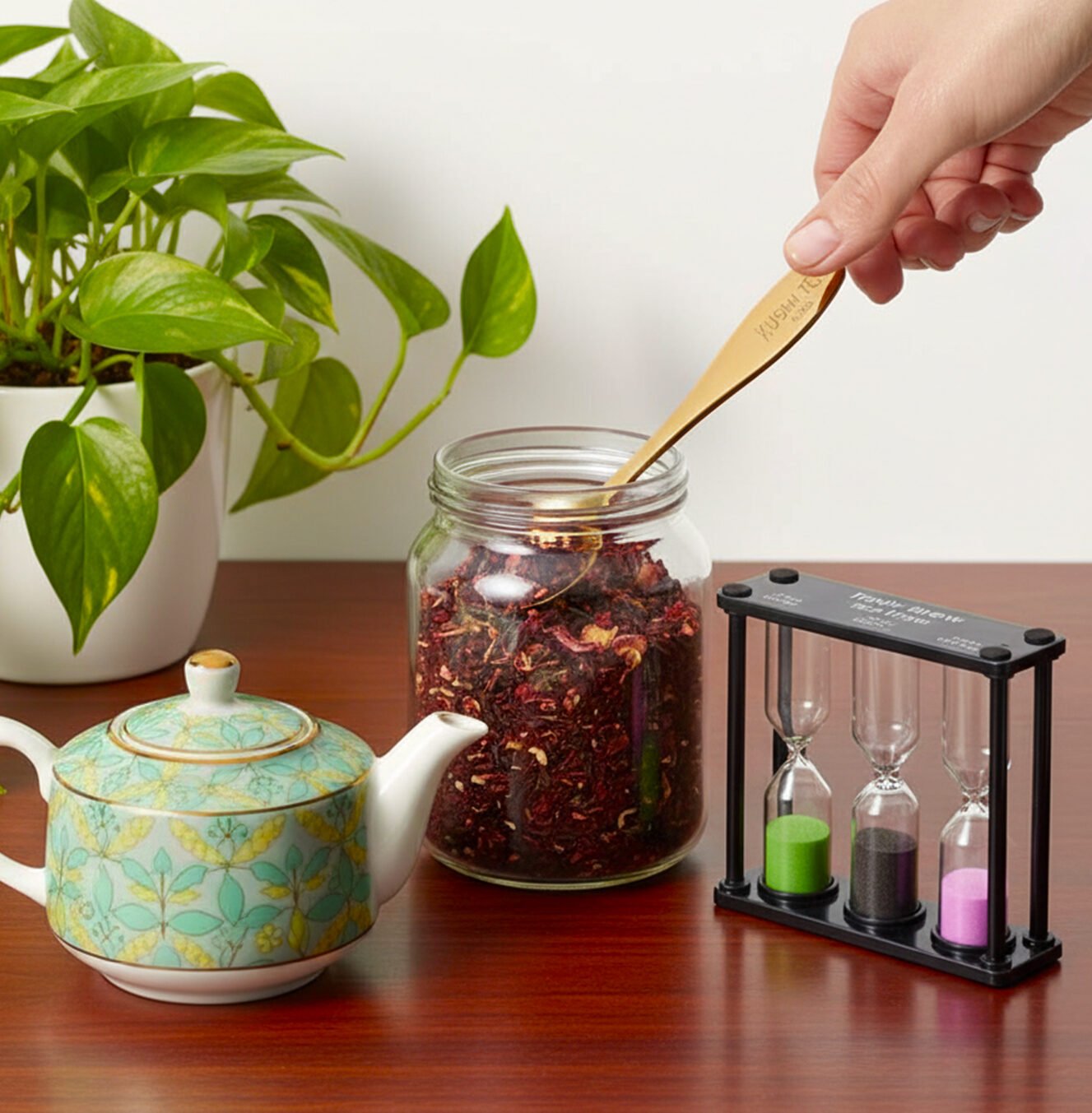
Herbal blends and pu-erh tea work best with a heaping teaspoon instead. Beginners might find it easier to use one teaspoon per eight ounces of water until they develop their taste preferences.
Tea leaves expand as they steep, so don’t pack your infuser too tightly. The leaves need space to unfurl and release their full flavor into the water. A kitchen scale can help you measure more exactly if you become serious about your tea routine.
The next crucial step involves timing how long your leaves steep in the water.
Steep the Tea for the Recommended Time
Timing matters greatly for brewing tasty tea. Each tea type needs specific steeping times to release its best flavors without becoming bitter. Black tea requires 3-5 minutes, while Japanese green tea needs just 1-2 minutes.
White and oolong teas steep best at 2-3 minutes, and pu-erh tea takes about 3-5 minutes to develop fully. Herbal teas and rooibos are more forgiving, needing 5-10 minutes to extract their full taste profile.
A kitchen timer helps you track the exact moment to remove your tea leaves. Many tea lovers find that steeping too long creates bitter cups, while too short leaves the flavor weak.
The perfect cup of tea depends on how strong you like your drink. You might prefer to steep black tea for 3 minutes instead of 5 if you enjoy milder flavors. Tea strainers or mesh filters make removing the leaves simple once your timer sounds.
Remove the Leaves and Serve
Take out your tea leaves as soon as the steeping time ends. This step prevents your brew from turning bitter and unpleasant. You have several options for removing the leaves – a mesh strainer works perfectly for tea steeped directly in water.
Simply pour your tea through it into your cup. For cold brew methods, a coffee filter or small colander catches even the tiniest leaf particles. Tea bags and tea balls make this process even simpler since you just lift them out of your cup.

Don’t toss those used leaves in the trash! They make excellent additions to garden compost.
The final step brings you to the moment of truth – tasting your perfectly brewed cup. Pour your strained tea into your favorite mug or teacup and enjoy it plain or with your preferred additions.
Some tea lovers add a touch of honey for sweetness, while others prefer a splash of milk with stronger black teas like English Breakfast. The beauty of brewing loose leaf tea lies in how you can adjust each element to match your personal taste preferences.
Now let’s wrap up what we’ve learned about making the perfect cup of loose leaf tea.
Conclusion
Brewing loose leaf tea brings joy beyond the cup itself. You gain control over flavor, strength, and quality with each batch you make. The right water temperature and steep time matter most for your perfect cup.
Fresh leaves, proper storage, and good tools make all the difference in your tea experience. Master these basics, and you’ll create amazing drinks that match your exact taste preferences every time.
FAQs
1. How much loose leaf tea should I use per cup?
We suggest starting with 1 teaspoon per 6-ounce cup for most tea types. You can adjust the amount based on how strong you prefer your tea. Check specific recommendations from your tea supplier for specialty blends.
2. What’s the best way to brew loose leaf tea without an infuser?
Place the tea leaves directly in your cup and pour hot water over them. When the tea is done steeping, strain it using a small mesh strainer into another cup. This method allows the leaves to fully expand and release their flavor.
3. How long should I let loose leaf tea steep?
Steep times vary by tea type. Black teas need 3-5 minutes, while green teas require just 1-2 minutes. Let it steep according to package instructions for the most flavourful tea.
4. Can I make iced tea with loose leaf tea?
Yes! Brew your tea at double strength, then pour over ice for instant iced tea. Cold brewing offers another excellent option—place loose leaf tea in cold water and let it steep in the refrigerator for 8-12 hours for a smooth, naturally sweet result.
5. What water temperature is best for brewing different types of tea?
Use boiling water (212°F) for black, herbal, and pu-erh teas. Green and white teas taste better with water at 175-185°F (79-85°C). The right temperature helps extract proper flavor without bitterness.
6. How can I tell when my water reaches the right temperature without a thermometer?
Watch for visual cues: tiny bubbles (175-185°F) work for green and white teas, medium bubbles (195°F (90.5°C)for oolong, and a rolling boil (212°F) for black and herbal teas. With practice, you’ll recognize these stages instantly.
7. Can I reuse loose tea leaves?
Absolutely! Re-steeping high-quality tea is highly recommended. Each infusion reveals new layers of flavor and aroma. How many times you can reuse the leaves often depends on your brewing method.
- Western Style (in a large mug/pot): Even with this common method, you can typically get 2-3 delicious infusions from quality oolongs, pu-erhs, white, and green teas.
- Gongfu Style (in a small pot/gaiwan): This traditional Chinese method uses a high leaf-to-water ratio and short steeps (6-8 grams for a 100ml vessel, steeped for 15-30 seconds). It’s specifically designed to explore the tea’s evolution over multiple brews, yielding 3-5 infusions for oolongs and often 5-10+ for pu-erh.
For either method, a good rule of thumb is to increase the steeping time slightly with each subsequent brew to maintain the flavor’s strength.
8. How can I store loose leaf tea to maintain freshness?
Store tea in an airtight container away from light, moisture, and strong odors. Most teas maintain good flavor for about six months to a year. Proper storage extends shelf life and preserves the delicate flavors of camellia sinensis leaves.
References
- https://twiningsusa.com/blogs/articles/perfect-cup-loose-tea?srsltid=AfmBOootPS6E3rdUgSkmoVg0pJzD0XbDaXR_4u9vd1kaElEX66jStu0v
- https://artfultea.com/blogs/101/how-to-prepare-tea?srsltid=AfmBOorGZewcVnHXFaSNykS_PYG8K3OG6VUDrBPBlwi039bqe4ex3m_C
- https://artfultea.com/blogs/101/how-to-prepare-tea?srsltid=AfmBOop6Yq85ed5mLdvcBDpK5XT8VtRQBmRlg2KqWfnD5cp48jXs04Vd
- https://twiningsusa.com/blogs/articles/perfect-cup-loose-tea?srsltid=AfmBOor4mFziOhcixrM36jy8aaITr7-TqA8fL1H66vS5rNLyb8YnnOdX
- https://twiningsusa.com/blogs/articles/perfect-cup-loose-tea?srsltid=AfmBOorqK4YnshgHO26JtWT9wRYrnFj00Sg-7sHNkGKak7sMX_CDcRWl
- https://twiningsusa.com/blogs/articles/perfect-cup-loose-tea?srsltid=AfmBOookxsIulPIbFN8MszFTale8XUZus7PTEzTHyleAW_cGIv6HywTg
- https://artfultea.com/blogs/101/how-to-prepare-tea?srsltid=AfmBOoqO2X3yolhaA9U7u3XjXlqFimryLZzuUJstjM6zqRu5Q-qH30eU
- https://twiningsusa.com/blogs/articles/perfect-cup-loose-tea?srsltid=AfmBOopBKusllgrlH3eDbg_nalVJrICG5Ui1Kl4qCProxgw10UVmTzjN
- https://teainspoons.com/2022/03/24/how-to-brew-the-perfect-cup-of-tea/

